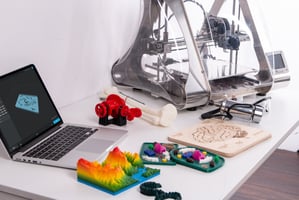Sketches and models are an essential stage in the engineering design process. However, 2D...
Regenerative Medicine in 2022
Engineers have always been at the forefront of medical advancement and have often invented technologies that improve quality of life. This is particularly true in regenerative medicine, where new therapies are developed to help restore function to tissues and organs. In this blog post, we will explore some of the current regenerative medicine therapies and discuss how they are improving patient care. We will also discuss some of the challenges associated with regenerative medicine and look at ways these can be overcome. Finally, we will provide an overview of some of the upcoming advances in this field that promise to improve patient outcomes even further.
Tissue regeneration
In the world of regenerative medicine, a few key therapies reign supreme. One of these is tissue engineering, which uses cells and biomaterials to create or regenerate tissues and organs. Scientists currently use regenerative tissue to treat conditions and injuries like burns, heart disease, diabetes, and liver failure. And now, a new study shows that it may also be used to treat spinal cord injuries.
One new treatment that uses human skin cells has been shown to help promote the growth of new skin tissue and reduce the chances of infection. This could be life-saving news for the thousands of people treated for burns each year. It has been extensively tested and is currently undergoing clinical trials at U.S. burn centers.
This therapy is uniquely designed from the cells of each individual patient. Skin cells are harvested and then sprayed in a mist over the injured area of the patient. The patient's own healing system then regrows the skin across the wounds. The breakthrough is still in its infancy but has been deemed near "miraculous" by patients who have undergone the treatment. Because the skin is healed by the patient's own body, scarring is minimized or even absent. The treatment currently works on 2nd degree deep burns, but researchers are optimistic that advances will enable them to treat severe 3rd-degree burns in the future.
Other innovations are in regrowing cartilage. Many joint injuries lead to the degeneration of cartilage and the development of arthritis in the joints. Using tissue regeneration techniques, scientists have managed to regrow cartilage inside patients reducing the need for costly and painful hip, knee, and shoulder joint replacements. Every year hundreds of thousands of patients undergo joint replacements, and many of these surgeries may be replaced with cartilage regeneration.
With advances in robotic surgery and arthroscopic technologies, surgeons are able to do even more complex surgeries with tiny incisions. The reduction in the size of incisions improves patient outcomes by reducing long-term pain, recovery times, and potential for infection.
Medical 3d Printing
3d printing of organs and other tissues holds the promise to save many lives and do away with the need for organ donation. At any given time, more than 100,000 people are awaiting organ donations, and the scarcity of organs is an even larger problem worldwide.
Advances in our understanding of the genetic and structure makeup of tissue have allowed scientists to recreate the physical structures of organs. As our understanding of structures improves, so do the treatments.
3D printing of organs is an upcoming technology that has the potential to revolutionize organ transplants. 3D printing involves creating a three-dimensional object from a digital model. This technology utilizes many different types of materials such as metals, plastics, and food and has already been used to create a wide array of objects for many different types of applications.
Now scientists are using the technology to create organs using human cells. Cells are the building blocks of all tissue, and scientists are currently working on ways to use 3D printing to create human organs for transplant.
There are several advantages to using 3D-printed organs for transplants. First, 3D printers can print any organ shape, which could potentially reduce the risk of rejection by the recipient's body. Second, 3D printers can replicate cells from the donor's own body, which would eliminate the need for immunosuppressive drugs. Finally, 3D printing could dramatically reduce the wait time for organ transplants.
While there is still more work to be done before this technology can be used extensively in transplants, the potential is astounding. Already, scientists have printed kidneys, livers, and even a heart! With continued progress, it may not be long before we can print any replacement organ that someone might need. This would revolutionize the way transplants are done and could save many lives. There are still many challenges to overcome before 3D printing of organs becomes commonplace, but the potential is definitely there.
In the early stages of regenerative medicine, concerns were raised worldwide about how scientists acquired stem cells. In some cases, embryonic cells were obtained from the fetuses of babies. The federal government put in place restrictions and regulations to manage research in order to alleviate ethical concerns.
Since the technology was first developed, scientists have developed new techniques to extract stem cells from the bone marrow of patients, from the umbilical cord blood of newborns, and even to grow cells in the lab. Stem cells are unique because they can replicate and change into different types of cells that make up the tissue in the body. For instance, muscle tissue and heart tissue are made up of different types of cells, which can be created from stem cells.
Regenerative medicine is a rapidly growing and evolving field, with new techniques and discoveries being made all the time. It is a transformative area of health care that will change how we think about treating injuries and illness. The potential for regenerative medicine is vast, and it will be exciting to see where the field goes in the future. Have you had experience with regenerative medicine? We'd love to hear about it.



